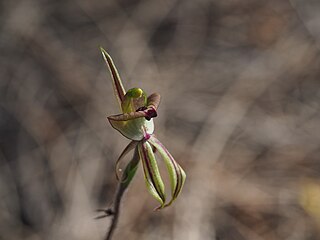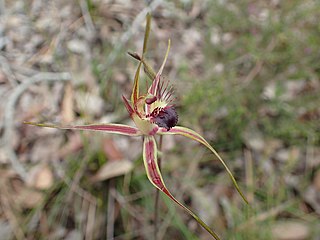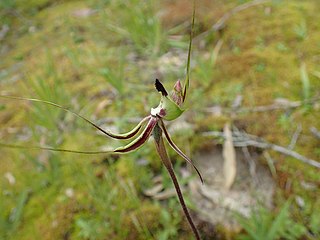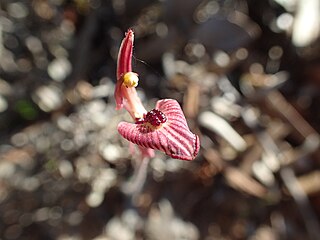
Caladenia paludosa, commonly known as the swamp spider orchid, is a species of orchid endemic to the south-west of Western Australia. It has a single erect, hairy leaf and up to three red, greenish-yellow and cream-coloured flowers. It mostly grows in dense scrub and is one of the last of the similar spider orchids to flower.

Caladenia attingens, commonly known as mantis orchids, are plants in the orchid family Orchidaceae and are endemic to the south-west of Western Australia. There are three subspecies, each of which has a single hairy leaf and one or two brightly coloured flowers with upswept sepals and a labellum with long, comb-like fringes. The subspecies differ in size, distribution and habitat.
Caladenia barbarella, commonly known as the small dragon orchid, is a plant in the orchid family Orchidaceae and is endemic to the south-west of Western Australia. It has a single broad, hairy leaf held close to the ground and a single greenish-yellow and red flower. It is only known from a small area near the Murchison River.

Caladenia brevisura, commonly known as the short-sepalled spider orchid, is a plant in the orchid family Orchidaceae and is endemic to the south-west of Western Australia. It is a common, small-flowered orchid with an erect, hairy leaf and a single greenish flower with red markings, on a flowering stem up to 25 cm (10 in) high. It is found between Ravensthorpe and Israelite Bay.

Caladenia brownii, commonly known as the karri spider orchid, is a plant in the orchid family Orchidaceae and is endemic to the south-west of Western Australia. It has an erect, hairy leaf and up to three flowers which are a combination of red, green, white and yellow. It is found in the high rainfall forests and coastal heath of the far south-west corner of Western Australia and is the only caladenia to grow in karri forest.
Caladenia drakeoides, commonly known as the hinged dragon orchid is a species of orchid endemic to the south-west of Western Australia. It has a single hairy leaf and a single greenish-yellow and red flower with a hinged labellum resembling a female thynnid wasp.

Caladenia excelsa, commonly known as the giant spider orchid, is a species of orchid endemic to a small area in the south-west of Western Australia. It is a rare species with a single, hairy leaf and up to three cream-coloured to greenish-cream flowers with long, drooping sepals and petals. It is one of the tallest spider orchids in Western Australia and, with Caladenia splendens, has the largest flowers of any Western Australian orchid.

Caladenia exilis subsp. exilis, commonly known as the salt lake spider orchid, is a plant in the orchid family Orchidaceae and is endemic to the south-west of Western Australia. It is a relatively common spider orchid with a single erect, hairy leaf and up to three white to greenish-cream flowers with a small white, red-striped labellum.

Caladenia exstans, commonly known as the pointing spider orchid, is a species of orchid endemic to a small area in the south-west of Western Australia. It has a single, hairy leaf and one or two green, yellow and red flowers with a labellum which does not curl downwards but "points" forward.
Caladenia fuscolutescens, commonly known as the ochre spider orchid, is a species of orchid endemic to the south-west of Western Australia. It has a single, hairy leaf and one or two brownish-yellow flowers with a pale yellow, red-striped labellum. It is most common in spring after bushfires in the previous summer.
Caladenia hoffmanii, commonly known as Hoffman's spider orchid is a species of orchid endemic to the south-west of Western Australia. It has a single, hairy leaf and one or two, greenish-yellow, red and white flowers which have a greenish-yellow labellum with a red tip. It is distinguished from the Pingaring spider orchid by small differences in the labellum and more northerly distribution.
Caladenia incrassata, commonly known as the puppet clown orchid is a species of orchid endemic to the south-west of Western Australia. It has a single, hairy leaf and usually only one greenish-yellow and red flower which has a red-striped labellum.

Caladenia infundibularis, commonly known as the funnel-wed spider orchid is a species of orchid endemic to the south-west of Western Australia. It has a single hairy leaf and up to three greenish-yellow flowers which have a red-tipped labellum.

Caladenia attingens subsp. attingens, commonly known as the forest mantis orchid or sneezing spider orchid, is a species of orchid endemic to the south-west of Western Australia. It is a relatively common orchid with a single erect, hairy leaf and one or two green, yellow and red flowers. It is similar to the fringed mantis orchid but has smaller flowers and has a more southerly distribution.

Caladenia attingens subsp. gracillima, commonly known as the small mantis orchid, is a species of orchid endemic to the south-west of Western Australia. It is a relatively common orchid with a single erect, hairy leaf and one or two green, yellow and red flowers. It differs from subspecies attingens in having smaller flowers and a more easterly distribution.
Caladenia attingens subsp. effusa, commonly known as granite mantis orchid, is a subspecies of orchid endemic to the south-west of Western Australia. It has a single erect, hairy leaf and one or two green, yellow and red flowers. It differs from the other subspecies of Caladenia attingens in having smaller flowers with lateral sepals which are not upswept and a labellum which is less than 15 mm (0.6 in) wide.
Caladenia luteola, commonly known as the lemon spider orchid, is a species of orchid endemic to the south-west of Western Australia. It has a single, hairy leaf and up to three lemon-yellow flowers with red stripes on the labellum. It is only known from two small populations near Woodanilling.

Caladenia macrostylis, commonly known as the leaping spider orchid, is a species of orchid endemic to the south-west of Western Australia. It has a single, hairy leaf and up to three distinctive pale greenish-yellow and red flowers with a cluster of deep purplish calli in the centre of its labellum.

Caladenia pachychila, commonly known as the dwarf zebra orchid, is a species of orchid endemic to the south-west of Western Australia. It has a single erect, hairy leaf and one or two greenish-yellow and red flowers with a red-striped labellum which has a dense cluster of deep purple calli in its centre. It is similar to the zabra orchid but has smaller flowers and the lateral sepals do not clasp the ovary.

Caladenia procera, commonly known as the Carbunup king spider orchid, is a species of orchid endemic to the south-west of Western Australia. It has a single erect, hairy leaf and up to four greenish-yellow and red flowers. It is one of the tallest and has amongst the largest flowers of the spider orchids.























